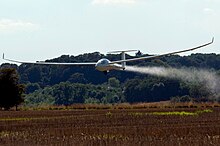Our website is made possible by displaying online advertisements to our visitors.
Please consider supporting us by disabling your ad blocker.
Gliding
 A Ventus-2 glider landing while jettisoning water that has been carried as ballast | |
| Highest governing body | Fédération Aéronautique Internationale |
|---|---|
| Characteristics | |
| Mixed-sex | Yes |
| Type | Air sports |
| Presence | |
| Country or region | Worldwide |
| Olympic | No |
| World Games | 2017 (aerobatics) |
Gliding is a recreational activity and competitive air sport[1] in which pilots fly unpowered aircraft known as gliders or sailplanes using naturally occurring currents of rising air in the atmosphere to remain airborne. The word soaring is also used for the sport.[2]
Gliding as a sport began in the 1920s. Initially the objective was to increase the duration of flights but soon pilots attempted cross-country flights away from the place of launch. Improvements in aerodynamics and in the understanding of weather phenomena have allowed greater distances at higher average speeds. Long distances are now flown using any of the main sources of rising air: ridge lift, thermals and lee waves. When conditions are favourable, experienced pilots can now fly hundreds of kilometres before returning to their home airfields; occasionally flights of more than 1,000 kilometres (621 mi) are achieved.[3]
Some competitive pilots fly in races around pre-defined courses. These gliding competitions test pilots' abilities to make best use of local weather conditions as well as their flying skills. Local and national competitions are organized in many countries, and there are biennial World Gliding Championships.[4][5] Techniques to maximize a glider's speed around the day's task in a competition have been developed, including the optimum speed to fly, navigation using GPS and the carrying of water ballast. If the weather deteriorates pilots are sometimes unable to complete a cross-country flight. Consequently, they may need to land elsewhere, perhaps in a field, but motorglider pilots can avoid this by starting an engine.
Powered-aircraft and winches are the two most common means of launching gliders. These and other launch methods require assistance and facilities such as airfields, tugs, and winches. These are usually provided by gliding clubs who also train new pilots and maintain high safety standards. Although in most countries the standards of safety of the pilots and the aircraft are the responsibility of governmental bodies, the clubs and sometimes national gliding associations often have delegated authority.
- ^ "FAI Commissions". FAI web-site. Fédération Aéronautique Internationale Aeronautique. Archived from the original on 2012-04-14. Retrieved 2012-04-05.
- ^ "Frequently asked questions about gliding" (PDF). FAI web-site. Fédération Aéronautique Internationale Aeronautique. Archived from the original (PDF) on 2011-06-06. Retrieved 2010-05-06.
- ^ "Gliding World Records". Fédération Aéronautique Internationale Aeronautique. Archived from the original on 2010-05-07. Retrieved 2010-05-06.
- ^ "Contest Flying". Soaring Society of America. Archived from the original on 2010-05-15. Retrieved 2010-05-06.
- ^ "Soaring Competitions" (PDF). Soaring Society of America. Archived from the original (PDF) on 2015-05-26. Retrieved 2010-05-06.
Previous Page Next Page


